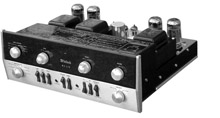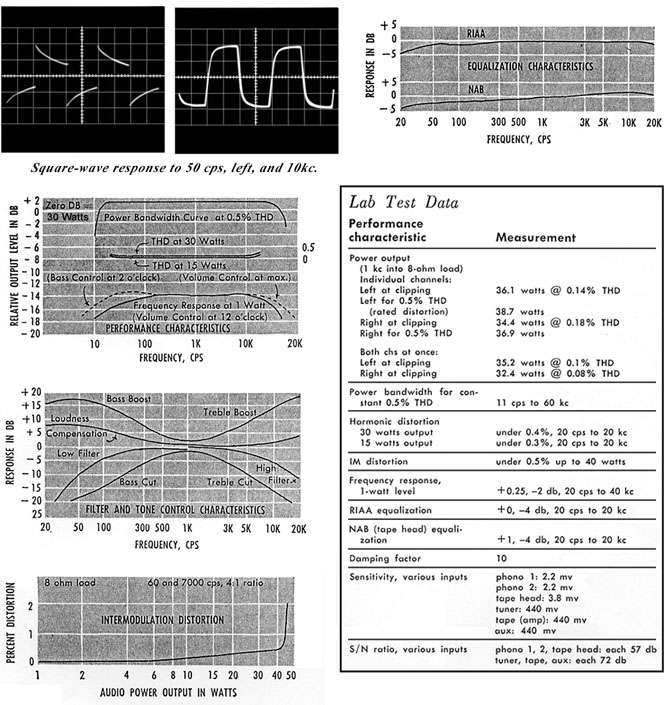 |
McIntosh MA-230 integrated stereo amplifier |
|
THE EQUIPMENT; Mclntosh MA 230, a stereo preamp-power amplifier. Dimensions: front panel, 16 inches wide by 5-7/16 inches high; chassis, 14-1/2 inches deep, including connectors; clearance in front of mounting panel including knobs, 1-1/2 inches. Price: $349; optional walnut cabinet, $29. Manufacturer: Mclntosh Laboratory Inc., 2 Chambers St., Binghamton, N.Y. COMMENT: The MA 230 by Mclntosh represents two "firsts" for this well-known audio manufacturer; it is the first "Mac" to make use of transistors and it also is this company's initial entry into integrated amplifier design. As such it demonstrates the audio adage of "handsome is as handsome does." One of the best- looking pieces of audio gear we have ever seen, it also is one of the best-performing. The MA 230 is well built too, in the sturdy Mclntosh tradition; operates flawlessly; and should provide years of trouble-free service. The front panel is a high-polished panoply of black and gold, on which a full complement of controls is logically arranged to facilitate operation and at the same time to present a pleasant visual design. A knob at the upper left is the program selector (aux, tape, tuner, phono 1, phono 2, tape head). To its right is a pair of dual-concentric bass tone controls, one for each channel. These may be operated independently or, inasmuch as they are friction-coupled, simultaneously. A small red pilot lamp occupies the centre of the panel. Next is the pair of treble controls; to their right is the volume control. Under the input selector is an unusually versatile mode selector. In addition to positions for stereo, re- verse stereo, and monophonic operation, this control also can be used for feeding the combined left-and-right inputs to either the left or right speakers, useful for balancing the amplifier and stereo speakers. It also has positions which feed either the left input or the right input to both speakers. A channel balance control is located at the lower right of the panel. Between it and the mode selector are eight rocker switches. From left to right, these are for: compensation or equalization (RIAA and the older LP characteristic); tape monitor; phase reversal; speakers off or on; AC power; low frequency filter; high frequency filter; loudness contour. Finally, the front panel has two stereo headphone jacks for direct connection of low-impedance headsets. At the rear of the amplifier is a barrier terminal strip for 4-, 8-, and 16-ohm speakers for each channel. There also is an output jack for feeding a derived "L + R" signal to an additional amplifier for a centre channel in the stereo installation, or for a mono- phonic version of a stereo program in another room. Output jacks for feeding a stereo tape recorder also are provided. There are seven pairs of stereo signal input jacks—the six that correspond to the settings of the program selector plus a pair for tape monitor. The rear also has a grounding post, a fuse-holder, and three AC outlets, two switched and one unswitched. The circuitry of the MA 230 is partly solid-state. That is to say, the preamp section uses transistors, and the power amplifier section uses tubes and specially designed Mclntosh output transformers. An inspection of the chassis indicates careful design and the highest quality of workmanship throughout: topside layout is designed for minimum heat interplay between the output tubes and other parts; the underside shows careful point-to-point wiring and the use of high- grade components. The circuit contains individual DC bias controls for the output tubes, and an AC balance control for the driver stage. These are factory-set and need not be readjusted except after prolonged use or tube replacement. The MA 230 is rated by the manufacturer at 30 watts power output per channel at 0.5% distortion over the range from 20 cps to 20 kc. In tests conducted at United States Testing Company, Inc., it met these ratings with room to spare, producing even higher power and lower distortion. The measured power bandwidth— from about 11 cps to 60 kc—would be excellent for any amplifier; in an integrated design it is quite remarkable. The normal frequency response of the amplifier (tone controls mechanically flat; volume control at 12 o'clock position) was within about 2 db over the 20-cps to 20-kc range, and was down only 3 db at 12 cps and at 50 kc. IM distortion remained under 0.4% up to the amplifier's rated power output, and was still under 0.5% at 40 watts output. The 10-kc square-wave response showed no ringing and good transient characteristics; the 50-cps response showed some rolloff in the extreme bass (below 20 cps), but, again, good transient action. The amplifier's power reserves and stability, combined with its fairly high damping factor of 10, would indicate its suitability for driving any type of speaker including the lowest efficiency models. Without doubt, the MA 230 is one of the finest integrated amplifiers available today, being both magnificently constructed and a pleasure to operate. It handles program material with the ease and authority of the superior instrument. Not to be overlooked either is the well-written and amply illustrated owner's manual, one of the most complete and easy to understand we have encountered. And, for the inveterate hobbyist or professional user, Mclntosh has printed, across the top of the front half of the chassis, a detailed block diagram of the amplifier's circuit.
|
|||
 Taken
from 'High Fidelity' magazine, December 1964
Taken
from 'High Fidelity' magazine, December 1964